RIMINI
Points of interest: between history, culture, relaxation and entertainment

Discover the main attractions of Rimini
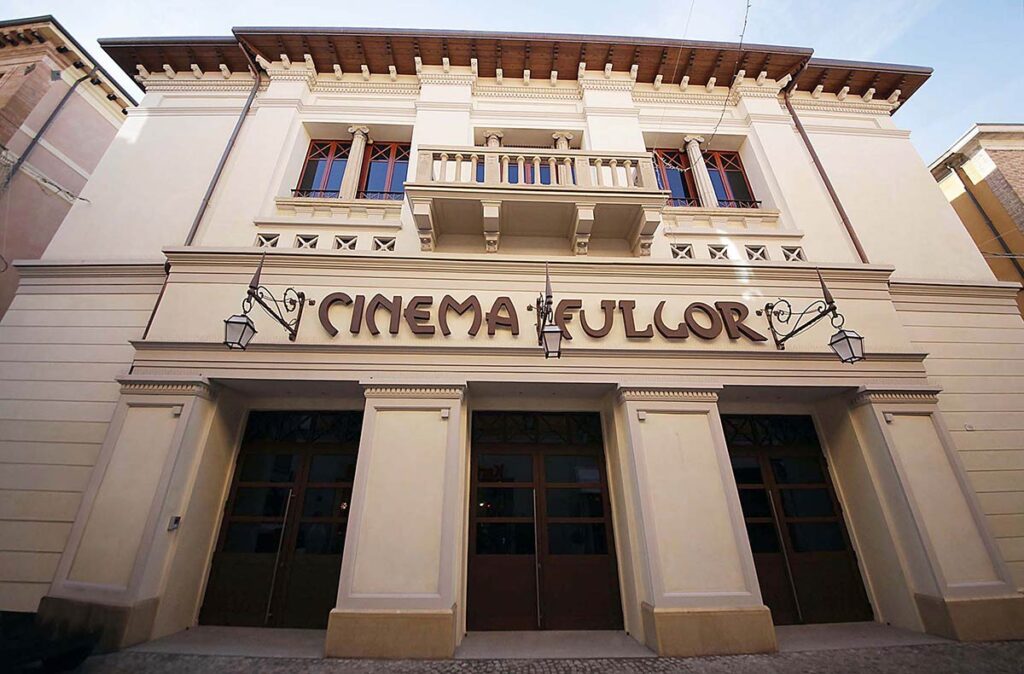
Cinema Fulgor
More than a cinema, a monument to culture. Celebrated throughout the world, Federico Fellini’s dream cinema. An iconic and stimulating place in the heart of the historic centre, which has found new life in the story of the streets frequented by the famous director.
Here the young Federico sees his first films, in a period in which his childhood imagination is fervent and sensitive. Here he begins to understand the power of the seventh art that will lead him on the path to success.
Teatro Galli
The Galli Theatre, a jewel of neoclassical architecture that plays a fundamental role in the history, culture and identity of Rimini and the people of Rimini.
Inaugurated to the public in October 2018, after 75 years of silence, it is characterized by its dimensions which have made it one of the largest theaters in Italy. The Galli Theater has been damaged several times: in the 1916 earthquake and during the Second World War. Since then it has never been reopened even though its restoration has been thought about several times.


Piazza Cavour
Piazza Tre Martiri

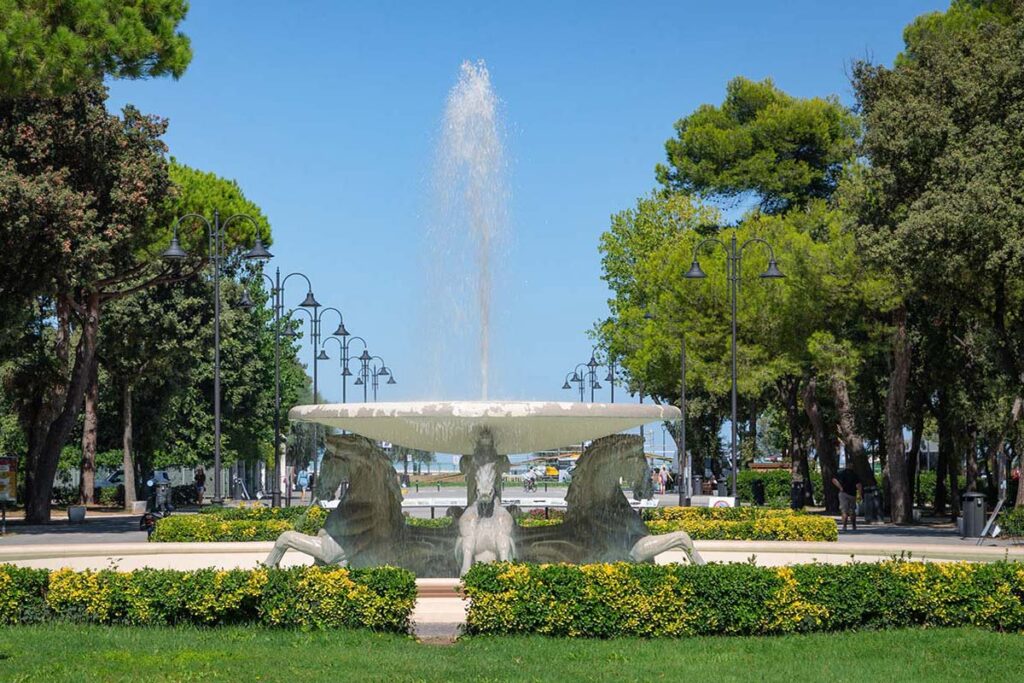
Parco Fellini
It is one of the symbolic places of seaside Rimini, in the heart of the marina, a meeting point for tourists and Rimini residents, a crossroads between the historic center of the city and its long beach.
The park, which develops a stone’s throw from the beach, is divided into large portions by the wide pedestrian streets that cross it alternating with large green areas. In a central position is the Fountain of the Four Horses, built in 1928. Since the nineteenth century it has represented the main gateway to the sea, which embodies the history and identity of the city.
Parco Del Mare
More and more greenery, nature, more spaces for sports, more cycle and pedestrian paths. This is the Parco del Mare, the major redevelopment project of Rimini’s seafront which, proceeding step by step, is transforming the 16 kilometers of Rimini’s seafront.
A naturalization and an orientation aimed at creating more spaces to live in the open air with services dedicated to well-being and quality of life, to respond to those needs and requirements that are essential today and which focus on well-being, environment and sustainable mobility.
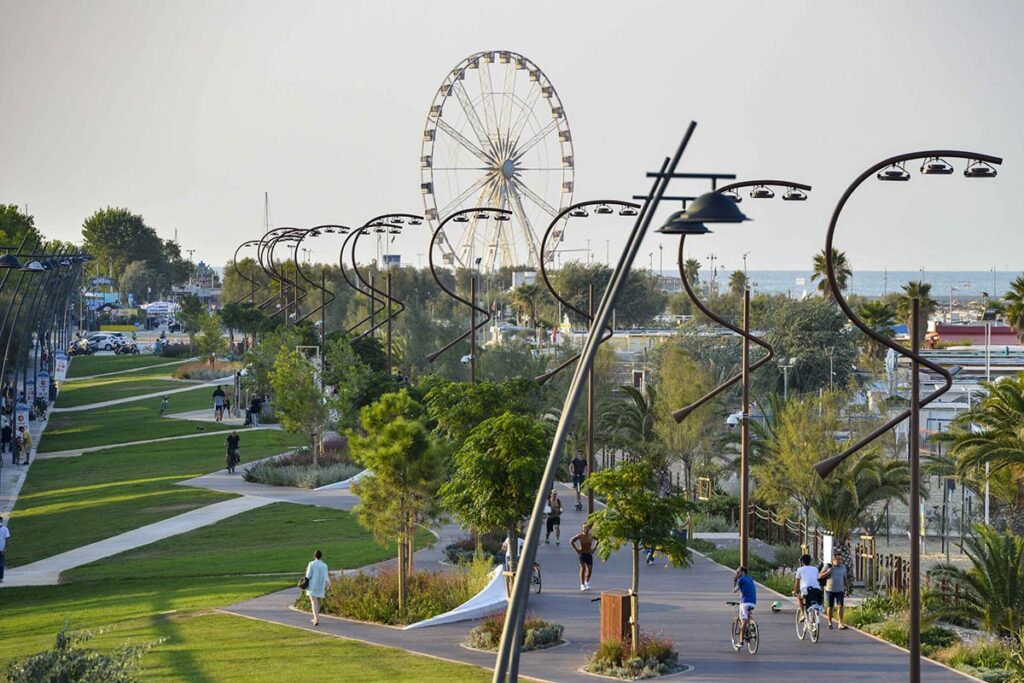

Ponte Di Tiberio
An imposing architectural work from the Roman era, the bridge was built over the Marecchia by decree of the emperor Augustus and its completion was due to his successor Tiberius (14 – 21 AD).
Made of Istrian stone, with five arches, in Doric style, it represents one of the most notable surviving Roman bridges; Symbol of the technical and engineering capacity of the Romans, the Tiberius Bridge has been a national monument since 1885.
Having survived earthquakes and the consequences of several wars, the Tiberius Bridge is still a key stopping point today and is currently pedestrianised.
Arco di Augusto
The Arch of Augustus is one of the oldest Roman symbols of Rimini, as well as a fundamental point of reference for the whole city. Il monumento si trova infatti nel centro storico, all’estremità del Corso d’Augusto, che attraversa tutto il centro fino ad arrivare al ponte sopracitato.
The monument today appears isolated, like a large triumphal arch, but originally, when it was built in 27 BC. it was inserted in the city walls between two older polygonal stone towers like the short remains of walls still visible today at the bottom of its sides, remains that belong to the first city walls of Roman Rimini.


Tempio Malatestiano
Tempio Malatestiano in Rimini is one of the most representative monuments of Renaissance classicism. The project of the temple-mausoleum wanted by Sigismondo Malatesta is the opportunity for Leon Battista Alberti to reinterpret the ancient according to the modern humanistic vision. This is not a new construction, but is the result of the transformation of a pre-existing building: the Church of San Francesco.
The latter was decorated with paintings now lost with the exception of Giotto’s Crucifix, the artist’s only work in Rimini, dating back to the early 14th century. Remained unfinished until today, this building is a plastic and articulated organism, with lively movement of solids and voids, of planes in relief and in depth.
Castel Sismondo
Castel Sismondo or Rocca Malatestiana was the home of Sigismondo Pandolfo Malatesta, Lord of Rimini from 1432 to 1468.
For Sigismondo the castle had to visually represent the fortress of power, according to a still entirely medieval conception, necessarily created in traditional forms. Symbol of the power of the Lord of the city, as well as a residence it served as a fortress. Very similar to a fortified citadel, the Fortress is made up of four parts communicating with each other: Palazzo Isotta (on three floors), the central body (on two floors), the large courtyard and the Maschio (central part with two floors connected via a helical staircase).
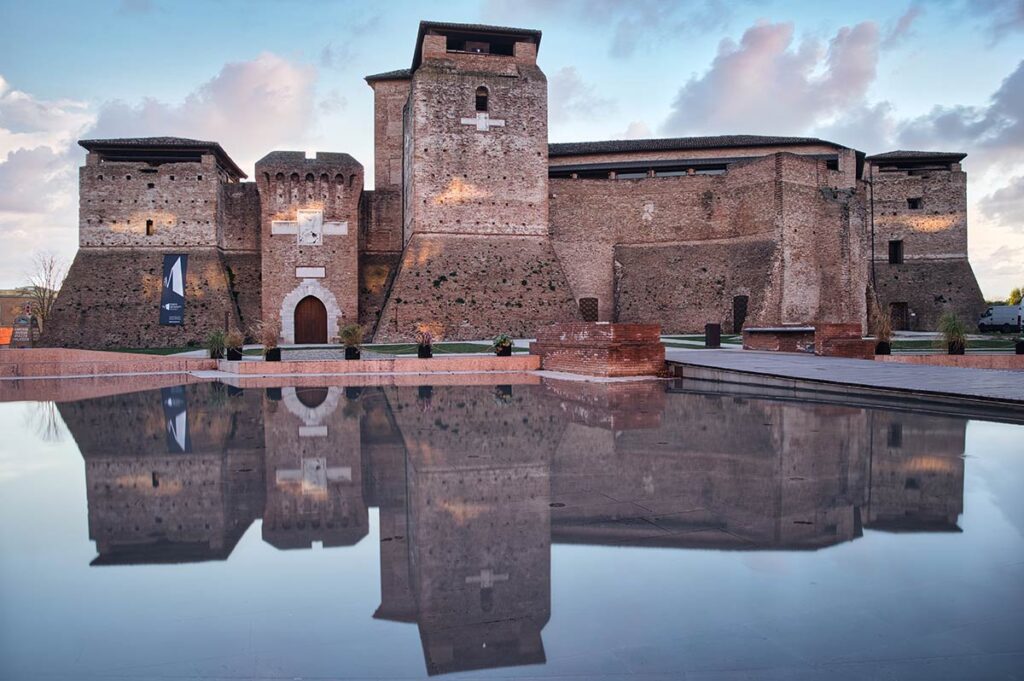
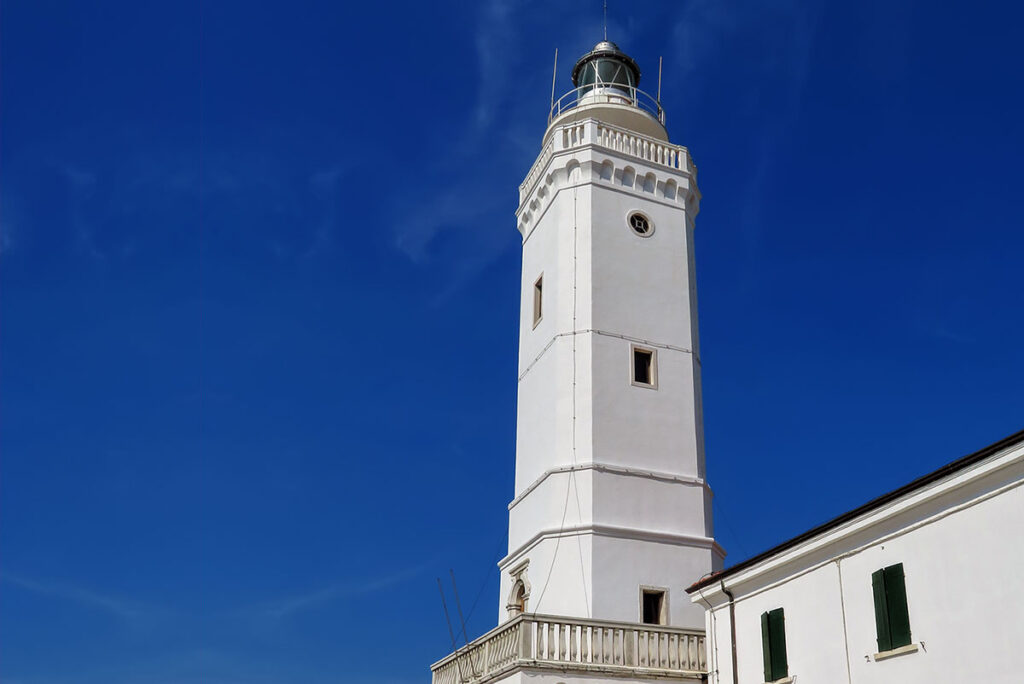
Il Faro di Rimini
From 1764 to today its light has helped countless boats and, through these two and a half centuries of uninterrupted operation, the Rimini lighthouse has witnessed wars, revolutions, destruction and new navigation technologies almost unscathed, passing from a light powered by oil , rigorously matured for 1 year, to the computerized management of all its functions. Over 27 meters tall, she has a light range of 15 nautical miles. Rotating optics were activated in 1862.
The white, quadrangular tower rests on a pyramidal trunk in Istrian stone, with a terrace. The Lighthouse and Maritime Signaling Service is entrusted to the Venice Lighthouse Area Command.
Porto Canale
The canal port of Rimini extends for a length of 1690 meters towards the interior of the city, a characteristic that characterizes the port as a vital and crucial element of the city and determines the strong bond that distinguishes the citizens of Rimini with their sea. The canal port is a real canal, which originates from the Marecchia river, in which the port of Rimini was subsequently built and allows the mooring of numerous boats.
The canal port can be reached thanks to the built network of cycle paths that connect the seafront, the new Sea Park, the historic center of the city and its attractions.
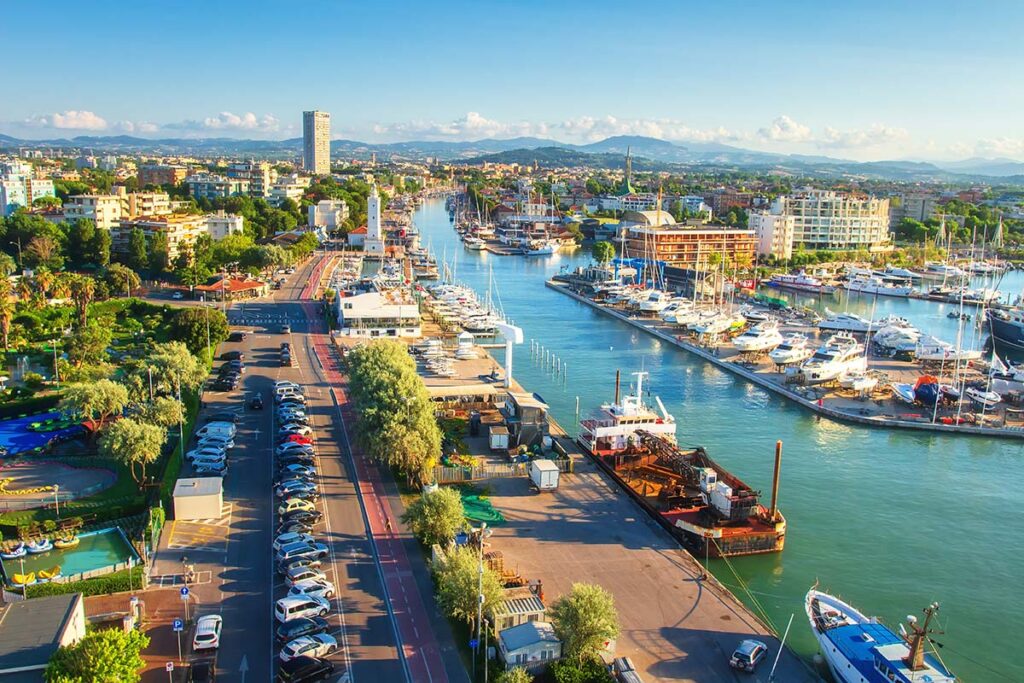

La Spiaggia
On approximately 15 km of fine, golden sandy beaches, there are two hundred and fifty shiny and constantly renovated bathing establishments. In Rimini the beach is lived by day and by night. It starts at dawn with walks on the shoreline to watch the sun slowly rise from the Adriatic and ends in the evening after a barefoot dinner on the sand.
An advantage is that there is no entrance fee to the beach. You can enter freely and if you decide to stop, ask the lifeguard for an umbrella or sunbed. For the people of Rimini the beach represents a second home, here the welcome is unique and of vital importance, so much so that it has become a real cultural identity with a century of history behind it.
Il Rockisland
The “Rockisland”, the restaurant on the eastern pier of Rimini, has been at the center of Rimini’s nightlife since the “legendary” 1960s when its name was “Belvedere”, a dance club in a strategic position, very romantic and ideal for “ embark”: one of the first venues to use “blacklight” or ultraviolet light where you dance in complete darkness: only white is the only visible color. A particular building that stands on a stilt on the rocks, built of wood, has been positioned on top of the pier since the mid-1920s, painted blue.
At the beginning of the 70s the place was destroyed by fire and, once rebuilt, in 1990 it was reborn as “Rockisland”.


San Giuliano
Leaving the historic center of the city behind and crossing the Tiberius Bridge, you find yourself in a small timeless village, with evocative beauty and delicacy: it is San Giuliano, a cluster of houses that line the northern bank of the Marecchia river, from which are divided into alleys, streets and small squares. So dear to Federico Fellini, the village has immortalized his memory with the large murals dedicated to him imprinted on the warm and colorful walls.
The village has always been rather independent from the rest of the city, from which it was separated by the Tiberius bridge. This contributed to preserving its identity intact and forming that magical and industrious atmosphere that can still be felt today.
Marina Centro
The Marina Centro area in Rimini, better known as the old “Marina” of the Rimini people, is recognized as the beating heart of the city and of summer city life, directly correlated with the historic center, which over the years has gathered events, adventures and stories to pass on. The Marina area was known in the past as the seaside center of Rimini full of events and shows, numerous artists, poets and songwriters had their say here.
The entire Marina Centro area is famous for its meeting points for young people, as it is full of bars and restaurants offering menus based on local foods, fish and piadina.

Do you need more information?
For all your requests you can contact us by phone, email or by filling out the form.



